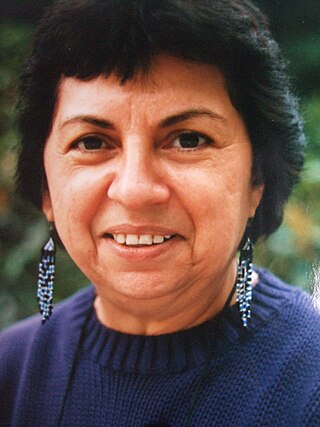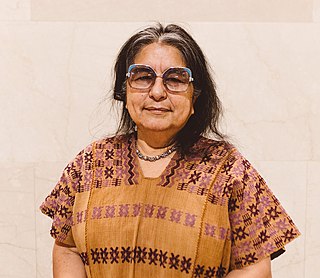
Chicano or Chicana is an ethnic identity for Mexican Americans who have a non-Anglo self-image, embracing their Mexican Native ancestry. Chicano was originally a classist and racist slur used toward low-income Mexicans that was reclaimed in the 1940s among youth who belonged to the Pachuco and Pachuca subculture. In the 1960s, Chicano was widely reclaimed in the building of a movement toward political empowerment, ethnic solidarity, and pride in being of indigenous descent. Chicano developed its own meaning separate from Mexican American identity. Youth in barrios rejected cultural assimilation into the mainstream American culture and embraced their own identity and worldview as a form of empowerment and resistance. The community forged an independent political and cultural movement, sometimes working alongside the Black power movement.

Maus, often published as Maus: A Survivor's Tale, is a graphic novel by American cartoonist Art Spiegelman, serialized from 1980 to 1991. It depicts Spiegelman interviewing his father about his experiences as a Polish Jew and Holocaust survivor. The work employs postmodern techniques, and represents Jews as mice and other Germans and Poles as cats and pigs respectively. Critics have classified Maus as memoir, biography, history, fiction, autobiography, or a mix of genres. In 1992 it became the first graphic novel to win a Pulitzer Prize.

Gloria Evangelina Anzaldúa was an American scholar of Chicana feminism, cultural theory, and queer theory. She loosely based her best-known book, Borderlands/La Frontera: The New Mestiza (1987), on her life growing up on the Mexico–Texas border and incorporated her lifelong experiences of social and cultural marginalization into her work. She also developed theories about the marginal, in-between, and mixed cultures that develop along borders, including on the concepts of Nepantla, Coyoxaulqui imperative, new tribalism, and spiritual activism. Her other notable publications include This Bridge Called My Back: Writings by Radical Women of Color (1981), co-edited with Cherríe Moraga.

Save Our State (SOS) is an activist organization opposed to illegal immigration in California. The organization's methodology revolves around the 'transference of pain' and it has been described as a hate group by the Southern Poverty Law Center.

Chicana feminism is a sociopolitical movement, theory, and praxis that scrutinizes the historical, cultural, spiritual, educational, and economic intersections impacting Chicanas and the Chicana/o community in the United States. Chicana feminism empowers women to challenge institutionalized social norms and regards anyone a feminist who fights for the end of women's oppression in the community.
Diane Gamboa has been producing, exhibiting and curating visual art in Southern California since the 1980s. She has also been involved art education, ranging from after-school programs to college and university teaching. Gamboa has been "one of the most active cultural producers in the Chicana art movement in Los Angeles." She actively developed the Chicano School of Painting.

Carmen Lomas Garza is an Chicana artist and illustrator. She is well known for her paintings, ofrendas and for her papel picado work inspired by her Mexican-American heritage. Her work is a part of the permanent collections of the Smithsonian American Art Museum, the Hirshhorn Museum and Sculpture Garden, the National Museum of Mexican Art, the San Jose Museum of Art, the Mexican Museum, the Pennsylvania Academy of the Fine Arts, and the Oakland Museum of California, among other institutions.

Laura Molina is an American artist, musician, and actress from Los Angeles, California. Molina is perhaps best known for her Naked Dave paintings. She is also the creator of Cihualyaomiquiz, The Jaguar, a self-published comic book printed under Molina's own Insurgent Comix imprint.
Amalia Mesa-Bains, is a Chicana curator, author, visual artist, and educator. She is best known for her large-scale installations that reference home altars and ofrendas. Her work engages in a conceptual exploration of Mexican American women's spiritual practices that addresses colonial and imperial histories of display, the recovery of cultural memory, and their roles in identity formation.
Yreina Cervantez is an American artist and Chicana activist who is known for her multimedia painting, murals, and printmaking. She has exhibited nationally and internationally, and her work is in the permanent collections of the Smithsonian American Art Museum, The Mexican Museum, the Los Angeles County Museum, and the Los Angeles Museum of Contemporary Art.

Carmen Tafolla is an internationally acclaimed Chicana writer from San Antonio, Texas, and a professor emerita of bicultural bilingual studies at the University of Texas at San Antonio. Tafolla served as the poet laureate of San Antonio from 2012 to 2014, and was named the Poet Laureate of Texas for 2015–16. Tafolla has written more than thirty books, and won multiple literary awards. She is one of the most highly anthologized Chicana authors in the United States, with her work appearing in more than 300 anthologies.

Emma Pérez is an American author and professor, known for her work in queer Chicana feminist studies.

Chicana art emerged as part of the Chicano Movement in the 1960s. It used art to express political and social resistance through different art mediums. Chicana artists explore and interrogate traditional Mexican-American values and embody feminist themes through different mediums such as murals, painting, and photography. The momentum created from the Chicano Movement spurred a Chicano Renaissance among Chicanas and Chicanos. Artists voiced their concerns about oppression and empowerment in all areas of race, gender, class, and sexuality. Chicana feminist artists and Anglo-feminist took a different approach in the way they collaborated and made their work during the 1970s. Chicana feminist artists utilized artistic collaborations and collectives that included men, while Anglo-feminist artists generally utilized women-only participants. Art has been used as a cultural reclamation process for Chicana and Chicano artists allowing them to be proud of their roots by combining art styles to illustrate their multi-cultured lives.

Consuelo Jiménez Underwood is an American fiber artist, known for her pieces that focus on immigration issues. She is an indigenous Chicana currently based in Cupertino, California. As an artist she works with textiles in attempt to unify her American roots with her Mexican Indigenous ones, along with trying to convey the same for other multicultural people.

Mickey au Camp de Gurs is a 1942 French comic booklet by German-born French cartoonist of Jewish descent Horst Rosenthal. It was created while Rosenthal was a prisoner at the Gurs internment camp in France during World War II. The comic features Walt Disney's Mickey Mouse, who is arrested on suspicion of being Jewish and is sent to Gurs. Rosenthal acknowledged the source of his protagonist by adding "Publié Sans Autorisation de Walt Disney" to the front cover. Rosenthal was detained in Gurs for two years before being sent to Auschwitz in September 1942; he was murdered on the day of his arrival.

The term Chicanafuturism was originated by scholar Catherine S. Ramírez which she introduced in Aztlán: A Journal of Chicano Studies in 2004. The term is a portmanteau of 'chicana' and 'futurism', inspired by the developing movement of Afrofuturism. The word 'chicana' refers to a woman or girl of Mexican origin or descent. However, 'Chicana' itself serves as a chosen identity for many female Mexican Americans in the United States, to express self-determination and solidarity in a shared cultural, ethnic, and communal identity while openly rejecting assimilation. Ramírez created the concept of Chicanafuturism as a response to white androcentrism that she felt permeated science-fiction and American society. Chicanafuturism can be understood as part of a larger genre of Latino futurisms.

A Mexican American is a resident of the United States who is of Mexican descent. Mexican American-related topics include the following:

Spiritual activism is a practice that brings together the otherworldly and inward-focused work of spirituality and the outwardly-focused work of activism. Spiritual activism asserts that these two practices are inseparable and calls for a recognition that the binaries of inward/outward, spiritual/material, and personal/political all form part of a larger interconnected whole between and among all living things. In an essay on queer Chicana feminist and theorist Gloria E. Anzaldúa's reflections on spiritual activist practice, AnaLouise Keating states that "spiritual activism is spirituality for social change, spirituality that posits a relational worldview and uses this holistic worldview to transform one's self and one's worlds."
Laura E. Alvarez born August 8, 1969, in Huntington Beach, California is a visual artist.
Felicia “Fe” Montes is a Chicana indigenous artist based in Los Angeles. Montes is a multimedia artist, poet, performer, educator, professor, and emcee. She is the co-founder and coordinating member of two creative woman's collectives, Mujeres de Maiz and In Lak Ech and El MERCADO y Mas. She also assists with organizing transnational art exhibitions including Zapatistas, Peace Dignity Journeys and La Red Xicana Indigena.













